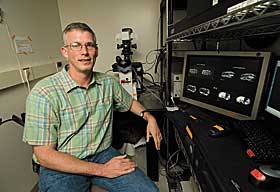  |
| HOME | THIS ISSUE | CALENDAR | GRANTS | BACK ISSUES | < BACK | NEXT > |
Worm offers clues to development of human musculoskeletal systemby Carolyn Pennington - October 23, 2006 | ||||
| The little round worm, better known in the scientific community as C. elegans, can be found just about everywhere. The ones being studied in Dr. William Mohler's genetics and developmental biology lab came from a garden in Bristol, England, but they could just as easily have been unearthed from a lawn in Farmington. Unlike the typical earth worm, the round worm is very hard to spot. It is only one millimeter long when fully grown and it is transparent - it has no pigment. That's what makes it so desirable. "That means we can do studies of the inner workings, the anatomy, and the behavior of cells without dissecting it," says Mohler, an associate professor of genetics and developmental biology at the Health Center who has been studying cell fusion in C. elegans for 10 years. "We can watch all the essential processes of life in these worms without killing them or opening them up." While many scientists are using C. elegans for research into the genetics of aging and other developmental processes, Mohler and his team are specifically studying giant cells in the skin. Understanding the mechanisms by which cells fuse during a worm's development can provide important clues about the formation of human skeletal muscle and the causes of degenerative muscle diseases. "The process of cell membrane fusion is essential to the development of virtually every animal species, allowing fertilization and the growth of bone, muscle, and placental tissue," says Mohler. "Yet the mechanism by which fusing cells recognize each other and merge their membranes is poorly understood." Another reason C. elegans is such a valuable research tool is that its life span is extremely short - only two and a half weeks. A newly hatched worm can become a mother in just three days. One worm may produce a brood of about 200 offspring, and you can get two generations within a week or two. So putting together family trees - the staple of genetic research - is a cinch. Even though each C. elegans only has 959 cells, that conglomeration of cells include an entire working nervous system, which helps the worms forage for food, find a mate, and avoid noxious chemicals and other dangerous contacts that could harm them.
They have a digestive, muscular, and excretory system, as well as an elaborate reproductive system that is able to pump out 200 baby worms in a week. "They've put together most of the essentials of being an animal with less than a thousand cells," says Mohler. "The truly unique thing about C. elegans as a model system is that from the time an egg is fertilized and divides into two cells, the fate of those other cells, what they will give rise to, and what those cells will function as, is invariant. It's the same from every worm to every other worm. So in terms of an experimental system, it's extremely predictable." Mohler and his team use high-tech imaging equipment to get a three-dimensional, high-resolution, "live" look at the structure of the worms' cell membranes within developing tissues. They can easily call up a "mini movie" on a computer that shows this intricate process in detail. Through this research, the researchers have been able to pinpoint the crucial protein - EFF-1 - that is responsible for fusing membranes together. According to Mohler, when that protein is missing or mutated, cell fusion doesn't occur. "And when we force the protein to be expressed itself in the wrong place, it can turn whole masses of cells into one big bag of soup," he says. "So EFF-1 is a key component in the mechanism of cell fusion, a process essential to normal animal development. "The round worm is the only organism in which the molecular mechanism of cell fusion is known at such a precise level," Mohler adds. "But there is still much more to be learned about this tiny yet complex animal that is providing us with some of the crucial information we need to figure out the workings of our own musculoskeletal system." |
| ADVANCE HOME UCONN HOME |

